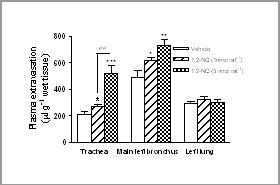Pharmacological study addressing the link between sensory C-fibers and airways inflammation evoked air pollutants Inflammatory conditions such as asthma and myocardial infarction have been associated with increasing exposure to ambient air pollutants including diesel exhaust particle (DEP), gases and chemical compounds (e.g. 1,2-naphthoquinone [1,2-NQ]; Kumagai et al., 1997; Vermylin et al., 2005). The are no pharmacological studies that have addressed the role of sensory-afferent nerve pathways in changes evoked by PED and 1,2-NQ. This study is aimed to examine the relationship between both DEP and 1,2-NQ and neurogenic inflammation in rat airways. Male or female Wistar rats ( 200 g) anaesthetised (i.p.) with ketamine and xylazine (10:1 mg kg-1) were used. 125I labelled albumin (2.5 μCi) was injected i.v. and all test agents (100 μl) were injected via the intra-tracheal route. After 15 min or 3 h, rats were killed. The trachea, bronchi and lung were removed and oedema formation was evaluated compared to plasma. Myeloperoxidase (MPO) activity assay was used as an index for neutrophil migration. DEP and 1,2-NQ were donated by Dr Kumagai. Data was expressed as mean ± s.e.m. and analysed by ANOVA, followed by Bonferroni’s t-test or unpaired t-test and considered significant if P<0.05. Short-term exposure to increasing concentrations of DEP or 1,2-NQ caused a dose-dependent oedema (Fig. 1A/B) but not leukocyte infiltration (not shown). Co-injection of DEP and 1,2-NQ, at low doses, evoked an additive response in leukocyte migration (0.10 ± 0.05, 0.12 ± 0.05 and 0.23 ± 0.03** U g-1 tissue for DEP, 1,2-NQ and mixture, respectively) and oedema in rat bronchi (103 ± 35, 592 ± 43 and 689 ± 24 μl g-1 tissue, respectively; n= 4-7). Capsaicin treatment to deplete neuropeptides markedly reduced the oedema but failed to affect MPO activity (not shown; n=4). The same profile was obtained with the NK1 receptor antagonist A5230 (5 mg kg-1 , i.p., -30 min; n= 4).
Fig 1. Panel A shows the effect of intra-tracheal injection of DEP whereas Panel B shows effect by 1,2-NQ. * Vs. vehicle and # vs. DEP or 1,2-NQ alone. DEP-induced plasma extravasation in rat airways is exacerbated by 1,2-NQ, thus suggesting that the latter can greatly account to induce vascular dysfunction. The sensory fibres (through probably substance P) are thought to be involved in mediating DEP and 1,2-NQ-induced plasma extravasation, but a distinct mechanism between pollutant-induced neutrophil migration and oedema is suggested.
Kumagai et al. (1997). Free Radical Bio. Med., 22, 479-487. We thank FAPESP/cnpq for financial support and MA Barreto for technical assistance. |



